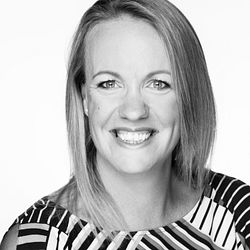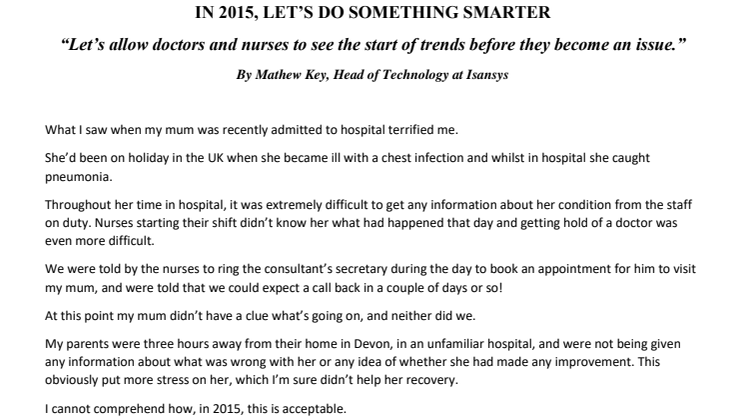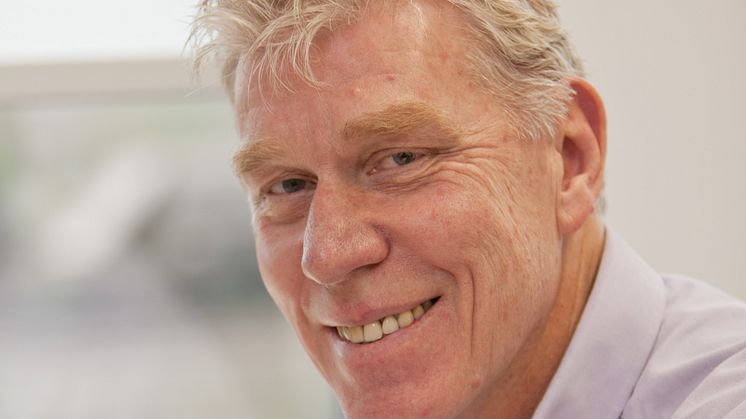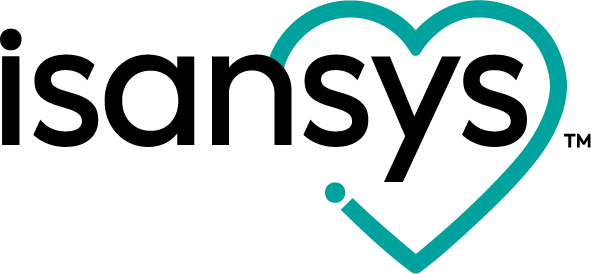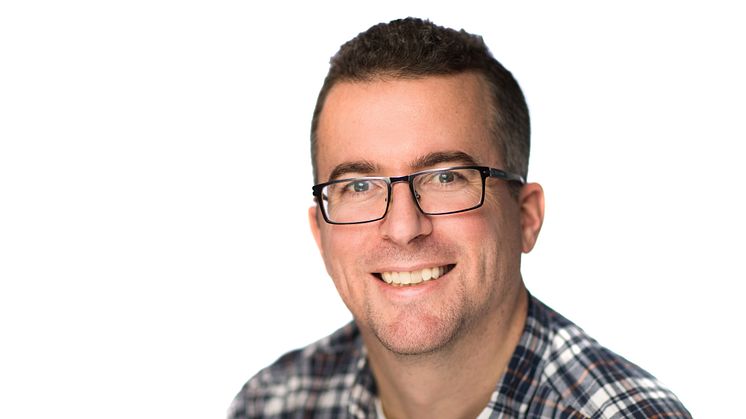
Blog post -
IN 2015, LET’S DO SOMETHING SMARTER
What I saw when my mum was recently admitted to hospital terrified me.
She’d been on holiday in the UK when she became ill with a chest infection and whilst in hospital she caught pneumonia.
Throughout her time in hospital, it was extremely difficult to get any information about her condition from the staff on duty. Nurses starting their shift didn’t know her what had happened that day and getting hold of a doctor was even more difficult.
We were told by the nurses to ring the consultant’s secretary during the day to book an appointment for him to visit my mum, and were told that we could expect a call back in a couple of days or so!
At this point my mum didn’t have a clue what’s going on, and neither did we.
My parents were three hours away from their home in Devon, in an unfamiliar hospital, and were not being given any information about what was wrong with her or any idea of whether she had made any improvement. This obviously put more stress on her, which I’m sure didn’t help her recovery.
I cannot comprehend how, in 2015, this is acceptable.
I’m not a clinician or indeed, medically trained. However I work for a company called Isansys, in Oxfordshire, which has developed an innovative, low cost and scalable patient monitoring platform, and so I’m familiar with the patient Early Warning Scoring system and therefore have a fair idea of what “normal” values of vital signs are. I also had a bag full of pulse oximeters (a device that measure the amount of oxygen in the blood) in the car having come from another hospital where Isansys is installing our patient monitoring systems, and I’m very glad I did.
I decided to monitor my mum myself and so, every day for the next 10 days, I put one of our pulse oximeters onto her finger to see if her condition was improving. After a week in hospital, the doctors decided to take her off oxygen. Over the next hour and a half, we watched her condition deteriorate and with the use of the pulse oximeter, I watched her SpO2 level dropping. It got to the point we couldn’t bear to watch her suffer any longer and called on a nurse to request she was put back on oxygen again as she was having difficulty breathing.
This is 2015 and here we were waiting for patient’s condition to deteriorate further before any medical help was given!
My mum is a proud lady who doesn’t like taking help from others, and, as there were lots of other patients in hospital, she said she “didn’t want to make a fuss”. If my family and I hadn’t been there, she would have carried on struggling to breathe.
Now imagine all the other patients who maybe didn’t have family visiting that day, or had difficulty breathing in the middle of the night - they would have just got worse and worse and would rely on nurses doing their rounds before someone even noticed they were in trouble.
In 2015!
As I sat there day after day, I started to question what was happening around me. Why are patients’ vital signs only measured every 6-8 hours?
A lot can happen in between the 6-8 hour vital signs measurements that is currently missed. Patients are deteriorating without anyone knowing about it.
One of the specialist doctors treating my mum, on seeing the Isansys pulse oximeter, started using it straight away for an update. To quote him “one of the banes of my existence is to make diagnoses on the basis of 6 hours old measurements”.
Why are we also waking patients up at two in the morning, to have their vital signs measured?
It’s hard enough to sleep in a hospital, let alone an unfamiliar hospital hundreds of miles from home, when you don’t know what’s wrong with you, without being woken up during the night to have your vitals taken.
At Isansys, we have created a solution for unobtrusive continuous monitoring 24/7. We allow doctors and nurses to see the start of trends before they become an issue. We allow patients one less thing to worry about knowing they are being monitoring 24/7. We allow patients to sleep better and therefore get better faster. We provide a live visual display of the patient’s vitals both at the bedside and via a web browser anywhere else. This lets medical staff check in and see how their patients are doing from anywhere.
In my mum’s case, her Sp02 level dropping would have been detected in minutes, and help would have arrived by itself rather than us having to ask for it. There would have been no need for the distress of not being able to breathe properly. Just a nurse coming over and saying “your blood oxygen is a bit low – let’s pop that oxygen back on”. That’s it. There would be no distress to the patient, no distress to the family, and no distress to the other patients on the ward having to listen to it.
Again, I’m not medically trained, but surely that’s got to help you get better quicker. The patient gets to go home faster and the hospital saves money. Everyone wins.
Its 2015 – let’s do things smarter.
